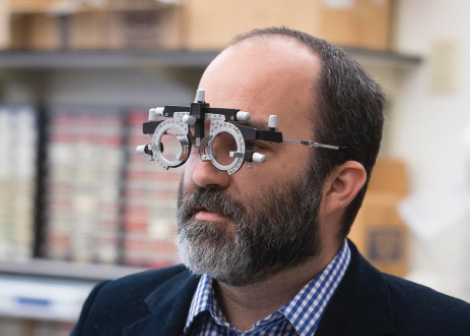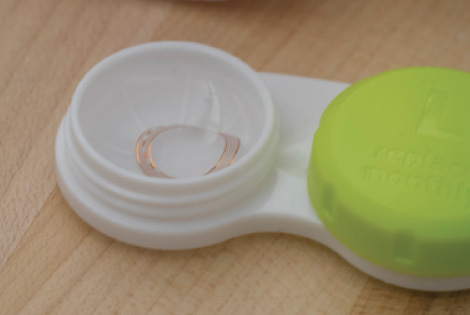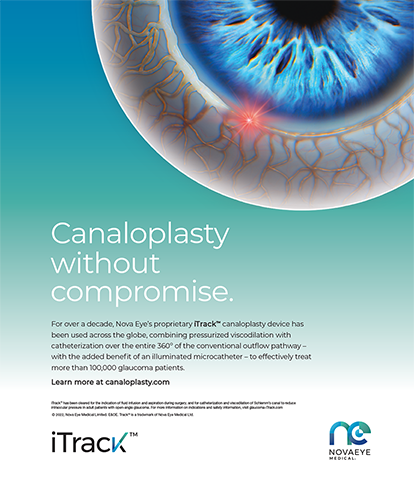In a decade marked by more glaucoma innovation than several that preceded it, the odds that another feature player would debut anytime soon seemed improbable. Nevertheless, a novel “electroceutical,” in the early stages of development, is generating serious industry buzz. The device is essentially a normal pair of eyeglasses modified to contain a coil, which produces a magnetic field that generates a current. The current flows through the ciliary muscles, and this transfer of energy provides the mechanism that results in IOP.
The technology, called Bionode, is the brainchild of Pedro Irazoqui, PhD, a professor of electrical and computer engineering and biomedical engineering at Purdue University (seen here), and glaucoma specialist Gabriel Simon, MD, of Barcelona, Spain, as well as Simon John, PhD, of the Jackson Laboratory in Bar Harbor, Maine.

Figure 1. Prof. Irazoqui wearing a Bionode prototype.
“What we're proposing here is a device that's as simple as wearing a pair of glasses that will treat IOP as [effectively] or more effectively than eye drops—and quicker,” said Prof. Irazoqui. “In animals, we’ve demonstrated that it’s fully reversible, and our findings show that we consistently see a change in IOP of 3 to 6 mm Hg in 10 to 15 minutes.”
A Unique Approach
Prof. Irazoqui says the approach is unique because of how the device works in tandem with the biological processes. “The technology uses electrical signals to work with the body to restore and control physiological production and drainage of fluid into and out of the anterior chamber of the eye,” he explained. “Our device regulates IOP naturally.”
Prof. Irazoqui serves as chief technology officer of Bionode, the small Purdue-affiliated startup company responsible for the innovative technology. The Bionode device originated in Purdue’s Center for Implantable Devices, where it has evolved over the past 4 years through an iteration of animal tests. The goal now is to complete a multisite clinical trial and apply for CE Mark approval in Europe and FDA approval in the United States.

Figure 2. A contact lens modified with a coil to generate electromagnetic fields.
The early research comprised a series of experiments in a variety of models and looked at using the glasses, either with or without a contact lens similarly modified with a coil to generate electromagnetic fields (Figures 1 and 2). The original design relied on glasses in tandem with a contact lens, but Prof. Irazoqui said, “When we discussed the device with ophthalmologists, we kept hearing that older people are often uncomfortable wearing contact lenses, because less tears are produced as people age. Given that most glaucoma patients are older, we thought we might run into a compliance issue if the device was dependent on contact lens use. That put some pressure on us to come up with an engineering solution that will allow us to get the same effect, the same current, and the same structures without the contact lens.” Once that was accomplished, said Prof. Irazoqui, “We found that we can essentially enhance the therapy with the contact lens but that we can get a reliable effect even without it using glasses alone.”
IOP-Lowering Goggles Rely on a Unique Mechanism of Action
The glaucoma pipeline is flush with promising technology. Among these innovations are IOP-lowering goggles currently in development by Equinox, an early-phase medical startup company headed by glaucoma specialist John Berdahl, MD.
“We are developing goggles that change the pressure in front of the eye to drive the pressure inside of the eye,” explained Dr. Berdahl, who invented the device and is shepherding it through the development process.
He sees the goggles fitting into the glaucoma treatment paradigm as an adjuvant to existing therapies to help lower IOP where it is most difficult.
“We think that this may allow treatment of some challenging glaucomas, such as normal-tension glaucoma and severe glaucoma, where other therapies don’t work as well, and we think we can do it in a safe, noninvasive way,” he said.
Among other things, Dr. Berdahl is known as a supporter of the theory that glaucoma is a two-pressure disease and that a low cerebrospinal fluid pressure may play a role in the progression of glaucoma.
“If it turns out that glaucoma is a two-pressure disease—a balance between IOP and intracranial pressure—the idea would be that, with the help of these goggles, we gain control of the IOP portion of the equation so that we can balance those two pressures out.”
-John Berdahl, MD
Multisite Clinical Trials
Clinical trials are ramping up at the Prism Eye Institute in Toronto, the Eugene & Marilyn Glick Eye Institute in Indianapolis, and the Instituto Oftalmologico Gabriel Simon in Barcelona. The trials aim to answer two pivotal questions:
1. How long does the IOP-lowering effect last?
2. How well does Bionode work in a controlled population of humans, with defined inclusion or exclusion criteria?
“We have 30 patients slated for each site, where we expect to confirm the effects that we’ve seen in our preliminary studies and begin to answer questions about durability and longevity,” said Prof. Irazoqui. “We have protocols at various stages of submission and review, and our hope is to start the multisite clinical trial by the end of the year.”
Possible Game-changer
Ike Ahmed, MD, an innovator of microinvasive glaucoma surgery (MIGS) and a clinical investigator in the Bionode clinical trial at the Prism Eye Institute, has been enthusiastic about the novel technology since its inception and has reportedly referred to it as a potential game-changer.
“The preliminary findings are promising,” Dr. Ahmed said. He added, “It's noninvasive and based on early findings, and in terms of theoretical possibilities, it does not seem to be of significant risk. I think the ability to acutely lower pressure but also potentially have a modulatory function where we may actually have more longer-term control is very exciting; I love the proposition.”
Dr. Ahmed continued, “The next steps are basically to enter human trials and to evaluate the outcomes in terms of optimizing the parameters for which this will work. I think it has great potential. It addresses adherence, it’s noninvasive, and it has a high degree of safety. Depending on what the efficacy looks like, I think it has a very promising role for all types of glaucoma.”
Prof. Irazoqui sees Bionode as an ideal option for newly diagnosed glaucoma patients. “It’s not so much a question of displacing the other therapies as saying that [patients] might want to try this first, because all they have to do is wear a pair of eyeglasses. If they need more, or if they need something else as time goes on, then they can move on to other treatments.”




